Orchard Notes: October 2020
While the world is still sorting out what comes next, we can count on this time of year to offer transition as the orchards are prepped for the colder months. In the office, the California Prune Board is underway with marketing the world’s best prunes, listening carefully to consumers and how they are eating for health, and adapting to more time spent at home. The good news is, we are well-positioned to help households achieve their wellness goals whether it’s eating healthier snacks or discovering the ideal premium ingredient for baked goods.
In this issue, we are pleased to share the latest information and best practices for continuous improvement in quality and the protection of your orchards. We also highlight opportunities to engage with the industry and participate in essential activities.
-Kiaran Locy
Director of Brand & Industry Communications
Coronavirus Food Assistance Program 2
California Prunes are now included within the Coronavirus Food Assistance Program 2 (CFAP 2). The program authorizes an additional $14 billion to a variety of agricultural sectors impacted by the COVID-19 pandemic.
The CFAP 2 application process is open now through December 11, 2020.
The California Prune Board is seeking information on the status of prune growers’ Coronavirus Food Assistance Program (CFAP) payment requests. Please complete a quick survey by clicking on this link: Grower Payments (CFAP) Survey. If you have already taken this survey for the Board, there is no need to complete it again.
SAVE THE DATE!
UC Prune Research Conference
Funded by CPB and coordinated by UCCE
Tuesday & Wednesday, December 1 & 2, 2020
Online via Zoom (agenda and registration TBA)
Topics/speakers will include:
- Cytospora canker: Dr. Themis Michailides, UC Davis Plant Pathologist
- Wood Rot Fungi: Daisy Hernandez, Ph.D. Candidate, UC Davis Plant Pathology Department
- Mechanical pruning trial research: Dr. Rich Rosecrance, Professor, CSU Chico
Get the latest updates on projects funded by the California Prune Board from UC, USDA, and CSU researchers. The annual meeting is a great way to stay informed on the investment made in production research and informs the research agenda for the upcoming year.
–
Long Pruning Webinar – Recorded
Did you miss the Long Pruning Webinar on June 10, 2020?
The webinar covered the UC research and grower experience with long pruning of prune trees during orchard establishment. Luke Milliron and Franz Niederholzer presented the UC research results. Joe Turkovich and Erick Nielsen discussed their innovative approaches to tree training from the grower perspective, and the session concluded with great questions and discussion.
Watch the recorded webinar here!
Cytospora: A Prune Grower’s Arch Nemesis
Franz Niederholzer, UCCE Farm Advisor in Colusa and Sutter/Yuba Counties
LukeMilliron, UCCE Farm Advisor in Butte, Glenn, and Tehama Counties
The Stakes:
Cytospora canker, caused by the fungus Cytospora leucostoma, can severely limit prune production; reducing grower income and potentially lead to early orchard removal due to scaffold and/or tree loss (see Photo 1). This bark disease is not new to prune orchards in California, but in recent years there has been a dramatic increase in this disease in some orchards. Why Cytospora has recently become more prevalent and severe is unknown. Some possible reasons include recent changes in pruning practices and warmer summer temperatures. All prune growers and PCAs working in prunes should be able to recognize the symptoms of and understand the current management recommendations for this damaging disease.
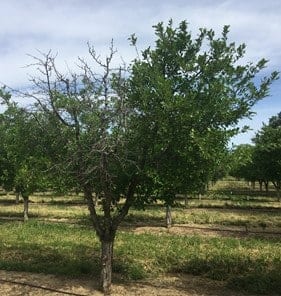
Photo 1. Cytospora canker damaged ‘French’ prune tree.
The Nemesis:
Cytospora is a so-called “weak pathogen” that needs a wound such as bark damage to enter the plant. Cytopsorainvades prune trees through natural or man-made breaches in the tree’s natural protective layers. These entry points include pruning wounds, sunburned bark, and bacterial canker damage. The location of these entry points is important to how damaging an infection can be.
Cytopsora infections spread with wind and rain from dead wood killed by the canker to unprotected wounds. The source of new infections are spores produced by disease structures called pycnidia (see Photos 3 and 4). Rain is required for spore release from the pycnidia. Wind is required to carry the spores beyond the infected tree. Research shows that high winds during a rain event can carry spores up to 250 feet from a source tree. Extended rain events have a greater infection risk than short periods of rain. Infections can occur anytime rain occurs, wounds are open and disease spores are present. The first good rainstorm of the season may produce a large spore release, as the spores build up in the pycnidia over time and cannot be released without rain.
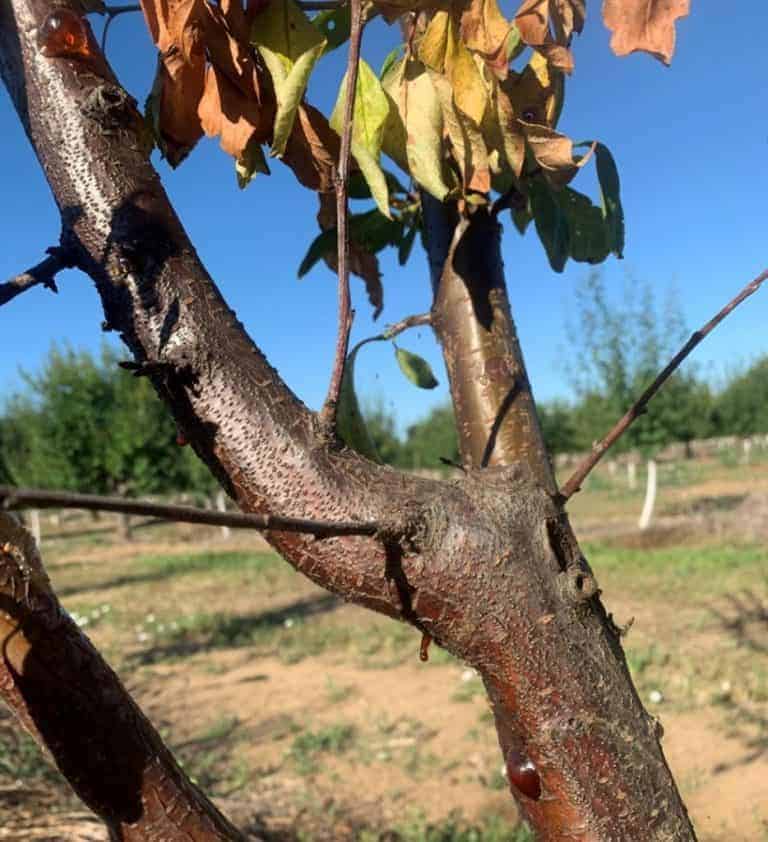
Photo 3. Cytospora pycnidia, the spore source of the Cytospora fungi. Black pycnidia turn white over time (see Photo 4).
When Cytospora infection occurs near branch tips, cankers can be readily pruned out if recognized. However, when pruning wounds are low on scaffold branches, the infection can spread to the crotch and trunk bark where girdling can rapidly occur. Dying trees often have diseased bark just above and below the crotch of the tree, while the bark at the top of the canopy appears healthy. These trees are effectively girdled and will not survive.
Cytospora spreads readily in prune trees under stress (heavy crop, nutrient, and/or water stress) during the summer and fall. Rapid spread is possible during this period because the fungus grows most rapidly at warm temperatures (roughly 80-90 degrees F). This means that orchards that look fine in the spring can look awful by fall.
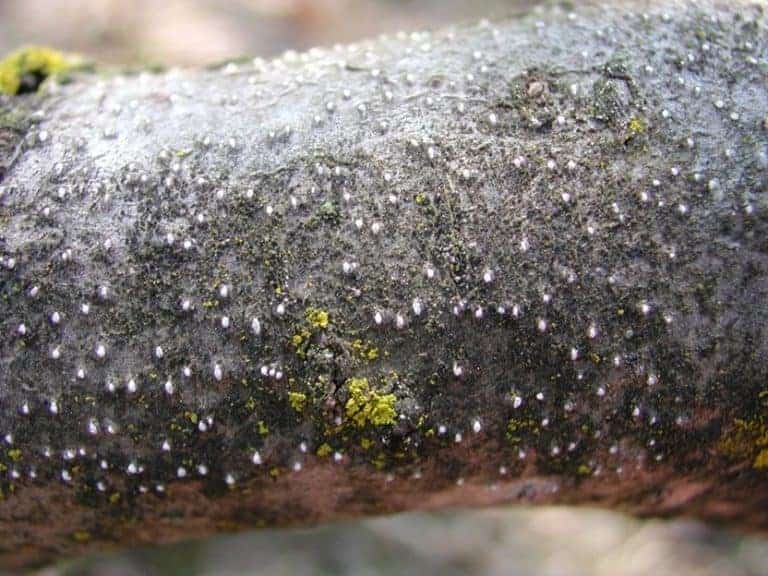
Photo 4. Cytopsora pycnidia on older wood.
Growth of a Nemesis:
Cytospora cankers don’t “die out” at the end of a growing season but remain in the tree from year to year. To remove Cytospora cankers from the tree, they must be cut out. Train yourself and/or pruners to recognize a good pruning cut that gets all the canker, from one that leaves the disease in the tree (see Photo 2).
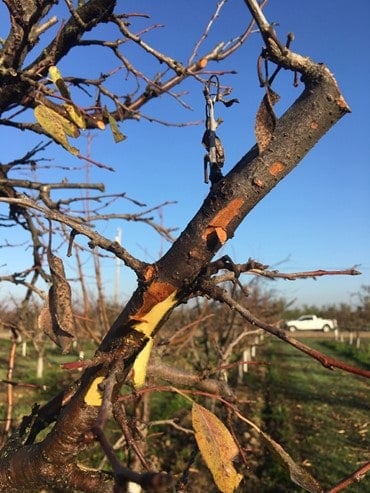
Photo 2. Pruning cut (upper right corner) that missed getting all the canker (inside red circle). It will keep growing down the branch.
A copy of a pocket-sized pruning guide that can be laminated so pruners can carry it with them is available at: sacvalleyorchards.com/prunes/pruners-pocket-guide-for-cutting-out-cytospora.
University of California research, led by Dr. Themis Michailides and funded by the California Prune Board, continues to increase our understanding of the development of canker diseases in prunes in general and Cytosporain particular. He and his lab have confirmed that pruning wounds are important Cytospora infection sites. In addition, Cytospora spores were the most common canker disease in spore traps in Sutter and Yuba Counties over a three-year period. Pruning wounds are vulnerable to infection for months after the cuts were made, although the vulnerability is greater soon after pruning. Fieldwork has documented that Topsin®-M fungicide (now with a 2EE label for pruning wound protection), applied directly to pruning wounds within a week of pruning, can reduce canker incidence. Other fungicides tested did not deliver the same, consistent results as Topsin®-M.
Why does it seem that this disease has blown up suddenly in many orchards? Why wasn’t it a bigger issue decades ago? Here are a couple of points that could help explain what is going on, as well as possible approaches to reduce damage.
- Changes in pruning practices. For decades, careful hand pruning was common in prune orchards. Skilled pruners cut out dry, dead wood (disease reservoirs) with saws as well as pruned branches and spurs with loppers. This significantly reduced the spore load in an orchard. Many growers burned prunings, eliminating any spores they contained.
- More hedging/topping. With the rise in pruning costs and limited availability of skilled pruners, many growers have moved to topping and/or hedging as a primary form of canopy management. This produces many potential infection sites. If done in the fall, when equipment can get into orchards, this practice produces multiple wounds ahead of maximum spore release. Hedging/topping is particularly risky when deep cuts are made into the canopy. Larger diameter cuts made by deep cutting take longer to heal than tipping cuts of the current year’s shoots. Hedging often does not remove all dead wood, so it leaves spore sources in trees while generating multiple potential infection sites (pruning wounds).
- Lots of interplanting: To increase production, many growers have interplanted young trees in existing orchards with wide traditional spacings. If the older trees contain a lot of Cytospora pycnidia, pruning wounds in the young tree will be at extreme risk of infection from the pycnidia just a few feet away. Learn more at: com/prunes/diseases-prunes/interplanted-orchard-hazards.
Fight Back:
What can growers do to reduce Cytospora risk in prune orchards? The following are some practices to strongly consider:
- Protect pruning wounds with Topsin®-M after pruning and before rain. This is especially important if you prune or hedge (by hand or with a machine), before the first good rain of the season. There is a pruning wound 2EE label for Rally® 40WSP in prunes, but Dr. Michailides reports that Topsin®-M is the key material to have in the tank. Tank partner inclusion of Rally® 40WSP may assist in resistance management.
- Make pruning cuts at the time of lowest infection risk. Hedge in the summer when little rainfall occurs. Delay any postharvest pruning until after the first major rains. Protect the cuts with Topsin®-M.
- Before leaf drop, send a crew through to 1) cut out dead wood and 2) remove dead wood prunings from the orchard and burn (if permitted). This timing allows crews to spot dead wood more easily than after leaf drop. If burning is not permitted, shred prunings with heavy-duty equipment (such as Flory WS910 or Rears Pul-Shredder) so that no intact pieces of wood remain. This should greatly reduce spore pressure from your orchard ahead of winter rains. This is particularly important in younger blocks where Cytospora is just getting started. Either paint the cuts with Topsin®-M or spray the whole block ahead of rain. This practice may not help as much if your up-wind neighbor doesn’t manage his/her prune trees in a similar way.
Research continues. If you have a young prune block or interplants that UC can use in a field trial of pruning timings, please contact Franz at (530) 218-2359.
–
Fall & Winter Prune Orchard Management Considerations
Luke Milliron, UCCE Orchard Advisor, Butte, Glenn, and Tehama Counties
Franz Niederholzer, UC Farm Advisor, Colusa, Sutter, and Yuba Counties
Dani Lightle, Former UCCE Orchards Advisor
Drew Alonso Wolter, Former UCCE Horticulture Intern
Irrigation
- As the days grow shorter and cooler, orchard irrigation needs decrease but don’t vanish. Manage post-harvest irrigation to minimize water stress, as this makes trees more susceptible to Cytospora canker spread compared to well-watered trees. Following harvest, water stress measured as stem water potential using a pressure chamber should be mild to moderate (-12 to -16 bars). Learn more about pressure chamber use at: com/manuals/stem-water-potential.
- Alternatively, use ET estimates, which are available for North and South Sacramento Valley at: com/et-reports). A final option is soil moisture evaluation with electronic sensors or by hand using an auger, to determine when and how much irrigation water to apply.
Orchard Clean-up
- Cytospora cankers will continue to grow unless they are cut out. Dead wood with Cytospora pycnidia are sources of new infections (see the photo of pycnidia in the article on Cytospora in this newsletter). Remove existing Cytospora cankers and spore sources by cutting branches several inches to a foot below the symptoms and burn prunings (if permitted). If an orchard has a lot of dieback/dead wood, consider a special crew or employee to just cut out diseased and damaged wood. This lets them focus on the cuts to clean up the orchard and not go back and forth between regular pruning cuts and orchard clean up. See the pruner’s pocket guide at: com/prunes/pruners-pocket-guide-for-cutting-out-cytospora.
- Clean up “barked” trees damaged at harvest. Trunk/limb damage from harvest can result in Ceratocystis canker infection and possible tree death. Cut away any loose or damaged bark back to “tight” bark with a sharp knife or chisel and hammer. Painting the wound with a commercial wound sealer can help protect damaged trunks while healing.
- Flag dying or weak trees for removal. Backhoe out old trees, making sure to get as many roots out of the hole as possible.
Pruning
- Avoid pruning when rainfall is imminent. If there is rain forecasted during the 30 days after pruning, strongly consider a fungicide spray (Topsin-M® or Topsin-M + Rally®) before the rain event to protect the pruning cuts.
- Remove and burn prunings (if permitted) to reduce in-orchard inoculum levels of bark cankers like Cytopsora. If you can’t burn, consider a powerful shredder to pulverize larger prunings in the field.
- Skipping pruning for a year is a significant cost-savings but be prepared to shaker-thin if needed next spring. If thinning isn’t done when needed, the savings from skipping pruning may turn into a net-loss after setting a large crop of small fruit and suffering increased sunburn, broken limbs, and increased Cytopsora
- If you are training a young orchard, consider intermediate or long pruning for earlier yields, but be prepared to tie your trees to support the longer growth. Learn more at: sacvalleyorchards.com/prunes/horticulture-prunes/long-pruning-for-greater-early-yields.
Orchard Topping
- If you are going to top your orchard in fall, top when there is no rain in the forecast. If rain is in the forecast, be sure to protect fresh wounds from infection by rain-splashed spores with a fungicide spray (Topsin-M® or Topsin-M® + Rally®). This must be done before the rain!
- Young, well-irrigated trees topped before mid-October will show some regrowth before leaf fall. Topping young, vigorous trees before a big wind will reduce the risk of blow-over.
Nutrition
- Tree nitrogen (N) uptake is limited in the fall (there is nothing to feed) and trees will not take up N once leaf drop has begun. N should not be soil-applied after September to avoid N leaching by winter rains.
- A fall foliar nitrogen (N) spray of 10-20 lbs N/acre may help reduce bacterial canker incidence next spring in young orchards, especially if summer leaf N levels are low. One 50 lb bag of good quality standard urea (or low biuret urea) contains 23 lb N.
- Soil applied potassium (K) should be banded in the fall. One dry ton of crop removes 26 lbs of potassium from your orchard. A common maintenance rate is 400-500 lbs/ac of K fertilizer (potassium sulfate). You can also opt to apply fertilizer K through a drip irrigation system (fertigation) and/or multiple foliar applications once a crop has been set next spring. Learn more at: com/prunes/horticulture-prunes/potassium-nutrition-maintaining-optimal-levels.
- Foliar zinc (Zn) to correct zinc deficiency can be applied at the beginning of leaf drop (late October/early November). 20 lbs of 36% zinc sulfate at 100 gallons water/ac may also hasten leaf drop, reducing the risk of blow over and/or disrupting aphid reproduction. [A low rate of pyrethroid insecticide can be tank-mixed with this zinc sulfate application rate and timing for good aphid control next year.]
- A lower rate of zinc sulfate (5 lbs material/acre in 100 gallons water per acre) is an effective zinc foliar fertilizer spray when applied ahead of natural leaf drop (late September or early October). This lighter rate will not accelerate leaf drop. This timing is too early for a pyrethroid tank mix to control aphids next year.
Insects
- Aphids: If there is a history of aphid problems and no need for a dormant scale or peach twig borer treatment, low rates of pyrethroids are effective when applied between mid-October and mid-December. Treating aphids in the fall, or during the dormant season in conjunction with scale/PTB treatments, has less impact on natural enemies than spring aphid treatments. Not every orchard needs to be treated for aphids. Detailed articles on prune aphid management can be found at com/prunes/insects-mites-prunes.
- Scale: Obtain dormant spur samples looking for San Jose scale and European fruit lecanium, as well as evidence of parasitism in both species. If significant parasitism is noted, treatments may not be necessary. More information on dormant sampling and treatment thresholds at: ucanr.edu/PMG/r606900511.html.
- Peach twig borer: During the dormant period, a moderate rate of pyrethroid is effective on aphids and PTB (6-8 oz/acre of Asana) without the need to use the maximum labeled rate (14+ oz/acre). Alternatively, Peach twig borer can be controlled at bloom, by tank mixing B.t. (DiPel®, Javelin®; doesn’t harm bees) with bloom fungicides.
- Visit sacvalleyorchards.com/prunes/insects-mites-prunes/aphid_management for a table of timing, efficacy, and other considerations for the treatment of these three pests.
Weeds
- Conduct a post-harvest weed survey (ucanr.edu/PMG/C606/prune-fallweeds.pdf) to evaluate your 2019 weed control program efficacy. More details on the value and keys to scouting at: sacvalleyorchards.com/almonds/weed-control/post-harvest-weed-scouting.
- Pre-emergence herbicide (combined with a post-emergence burn-down material if winter weeds have already germinated) should be applied shortly before a moderate rain event (0.25”) to move material into the soil. Avoid application prior to a large rain event (> 1”), which can move the product too deep into the soil for good weed control. Avoid spraying root/trunk sucker leaves with any spray containing systemic herbicides such as glyphosate (Roundup, etc.) since those herbicides can enter the tree and cause damage next spring. More information on fall weed management at: com/prunes/fall-weed-management.
Gophers
- Late fall to early winter is a prime gopher control time because populations are low and can be controlled before adults breed and create more gophers. See gopher control strategies at: ucanr.edu/PMG/r606600311.html.
Replants
- Before replanting in winter, consider the probability of a successful replant by evaluating why the previous tree died and if management lessons can be applied for the entire orchard. Also, consider the longevity of the larger orchard and whether a replant will have enough time to become profitable. Replanting with bare-root, instead of a potted tree will give you a larger and easier tree to irrigate.
- Pruning replants exposes them to Cytospora infection from inoculum already present in mature orchards. Consider protecting new pruning wounds with a fungicide spray (Topsin-M® or Topsin-M + Rally®). Risks are particularly high in interplant situations, with a high number of newly planted trees: com/prunes/diseases-prunes/interplanted-orchard-hazards.
- Was the tree lost to a soil-borne disease? If so, is spot fumigation an option? Could a different rootstock choice increase the chance of success? See the latest update on rootstock performance and survivability in UC trials at: com/prunes/horticulture-prunes/update-on-rootstocks-2019.
–
New UC Davis Prune Cultivars Prove Promising
Sarah Castro & Dr. Ted DeJong, Prune Breeders, UC Davis Department of Plant Sciences
The UC Davis Prune breeding program is eager to promote three promising new cultivars that have excited growers. The new cultivars offer a range of superior flavors, harvest dates, pruning strategies and dry away ratios. This year, all three cultivars were dried using commercial dehydrators in cooperation with interested growers. Not all information has been returned from the dryers for the 2020 harvest, but preliminary results are very encouraging. As shown in the data table below, the dry away ratios are low, and the sugars are high for these three items. All three have been successfully pitted in previous years but will be processed again using commercial processors.
Table 1. 2020 Summary data for the three promising new cultivars from the UC Davis prune breeding program. All items have a limited number of nursery budded trees available for growers to plant in their orchards for testing.
| Item Name | Date harvested | Location harvested | Pressure | Soluble solids (BRIX) | Dry Away Ratio | 2019 Count per lb | Fresh Fruit Color | Dried Fruit Color |
| Solano Gold (F11S-38) | 8/4/20 | Winters | 2.1 | 33.3 | 2.6 | 48.6 | Yellow | Dark Brown |
| Yolo Gold (G2S- 8) | 8/31/20 | Winters | 3.4 | 24.8 | 2.8 | 52.9 | Yellow | Dark Brown |
| H13S- 58 | 8/19/20 | Madera | 2.3 | 26.4 | 2.8 | *46.5 | Yellow | Dark Brown |
| 8/31/20 | Winters | 4.3 | 28.4 | 2.5 | 64.5 | |||
| *2020 Data | ||||||||
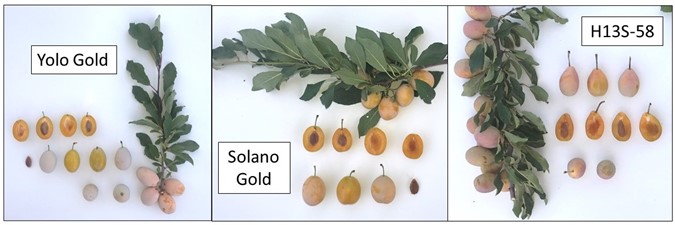
Solano Gold
Solano Gold (test name F11S- 38) is a vigorously growing tree that produces round, yellow fruit. It ripens one month before Improved French and starts to dry on the tree before harvest. Its ability to dry on the tree creates an unusually low dry away ratio upon dehydration. The dried fruit comes out of the dryer with a deep mahogany color and darkens as the dried fruit is stored. The 2019 fruit was pitted via an Ashlock pitter and the fruit was given away as samples during the Prune Summit in February 2020.
Yolo Gold
Yolo Gold (test name G2S- 8) is an upright growing tree that produces oval, yellow fruit. The tree is precocious and will usually produce fruit in its second leaf. The tree should not be long-pruned, and crop loads are consistently high most years, thus requiring thinning. The fruit is typically larger than Improved French and has superior fresh and dried flavor in comparison to Improved French.
H13S-58
H13S-58 is a tree with yellow fruit that also begins to dry on the tree. Its fruits’ ability to dry on the tree can create unusually low dry away ratios and durable fruit that can withstand many hours in the bin before drying. The fruit harvests 1-2 weeks after Improved French but has such a long harvest window, and it can be harvested early with Improved French when necessary (see Madera harvest data in Table 1). Anecdotal feedback from growers with trial trees claims H13S-58 would not need as much pruning as Improved French because it does not grow many excess branches. It might be a candidate for mechanical hedging because it does not appear to respond to pruning with excess growth. Mechanical pruning compatibility has not yet been investigated by the UC Davis breeding program. This tree is extremely precocious and will not do well with long pruning. Notes from a grower with second leaf trees said he needed to thin his second-year fruit so that it would not over-crop too early. The breeding program highly recommends to not grow too much fruit during its second leaf, otherwise, the tree will not set up strong scaffolds for future crops.
Advanced Selections
In addition to these three new selections, we have obtained very encouraging results from a set of six new advanced selections that include five with purple and one with yellow fruit that mature before and along with Improved French. All selections develop fruit with very high sugar content and have low dry away ratios and great taste (see Table 2). They offer differing harvest dates but produce dried fruit that would be able to be easily mixed with Improved French. We are looking for grower cooperators to plant test trees of these items. If you are interested in becoming a grower cooperator, please notify the program manager, Sarah Castro (scastro@ucdavis.edu).
Table 2. Newest promising items available for testing from the UC Davis Prune Breeding program. All items start to dry on the tree before harvest and have had at least two years of promising fresh and dried evaluations.
| Item Name | Date harvested | Pressure | Soluble solids (BRIX) | 2019 Dry Away Ratio | 2019 Dry Count per lb. | Fresh Fruit Color |
| G37S-45 | 8/17/20 | 6.0 | 27.9 | 2.7 | 47.8 | Purple |
| I11N-63 | 8/10/20 | 3.0 | 30.5 | 2.7 | 52.9 | Yellow |
| I12S-6 | 8/24/20 | 4.7 | 33.1 | 2.4 | 44.6 | Purple |
| *J2N-127 | 9/3/19 | 4.7 | 36.7 | 2.4 | 48.1 | Purple |
| *J2N-128 | 9/3/19 | 4.8 | 32.2 | 2.5 | 52.7 | Purple |
| *J2N-79 | 9/3/19 | 6.7 | 27.7 | 2.6 | 42.9 | Purple |
| *2020 data still processing | ||||||
The UC Davis breeding program would like to thank participating grower cooperators. Because of you, the program was able to perform multiple tests this year. A few growers not only grew the trees but helped transport fruit and encouraged their processors to get involved. The collaboration between growers, the breeding program, and the processors is essential for determining the acceptability of these items for commercial production.
The prune breeding program is funded by the California Prune Board. The goal of the breeding program is to breed new cultivars that will save growers on operational costs and stabilize prune production in California. The main costs the program tries to reduce are drying costs (via dry away ratio) and pruning costs. The program has many new items every year that are commercially viable candidates for future releases. The items in the seedling test blocks prove to be more and more remarkable as the years unfold. The program is confident that they have items that can save growers’ production costs and stabilize cropping. The new items in Table 2 have been budded by Sierra Gold Nursery and are ready for grower trials.
For more information about these items please contact Sarah Castro at scastro@ucdavis.edu
–
Share Your Family Prune Recipes!
The stories and family traditions from California’s rich prune heritage is an authentic way to build brand trust and connect with consumers. This year, the California Prunes team will feature treasured family recipes from our farmers, and we would love to hear from you! Is there a prune dish everyone requests? What’s your favorite prune recipe? Is there a way your family enjoys prunes that has been passed down through the generations? Have you adapted an old recipe to make it your own?
We want to know! Please submit ideas to aconsulo@prunes.local. Be sure to tell us your name, a little bit of background on the dish, or how you cook with prunes, and where this fits into your family story.